Accounting Theory and Current Issues: AASB 16 Lease Standard Report
VerifiedAdded on 2020/12/18
|11
|3677
|373
Report
AI Summary
This report provides a comprehensive overview of accounting theory, with a specific focus on lease accounting and the evolution of standards. It begins with an evaluation of the old accounting standard, AASB 117, highlighting its drawbacks, such as the distinction between operating and finance leases and the potential for off-balance sheet financing. The report then explains the rationale behind the changes in accounting standards, emphasizing the need to remove off-balance sheet financing and improve the representation of leases in financial statements. It details the changes incorporated in the new standard, AASB 16, and its alignment with IFRS 16, including the new definition of a lease and the requirement to recognize lease assets and liabilities on the balance sheet. The report further examines the impact of these changes on companies, including the increased transparency and a more accurate reflection of financial position. It also discusses the relation of positive accounting theory and managers' behavior of classifying maximum leases as operating lease. Finally, it analyzes the effect of AASB 16 on the leasing market and summarizes key disclosures companies are required to make regarding their lease accounting practices. The report emphasizes the importance of understanding these changes for both lessors and lessees.
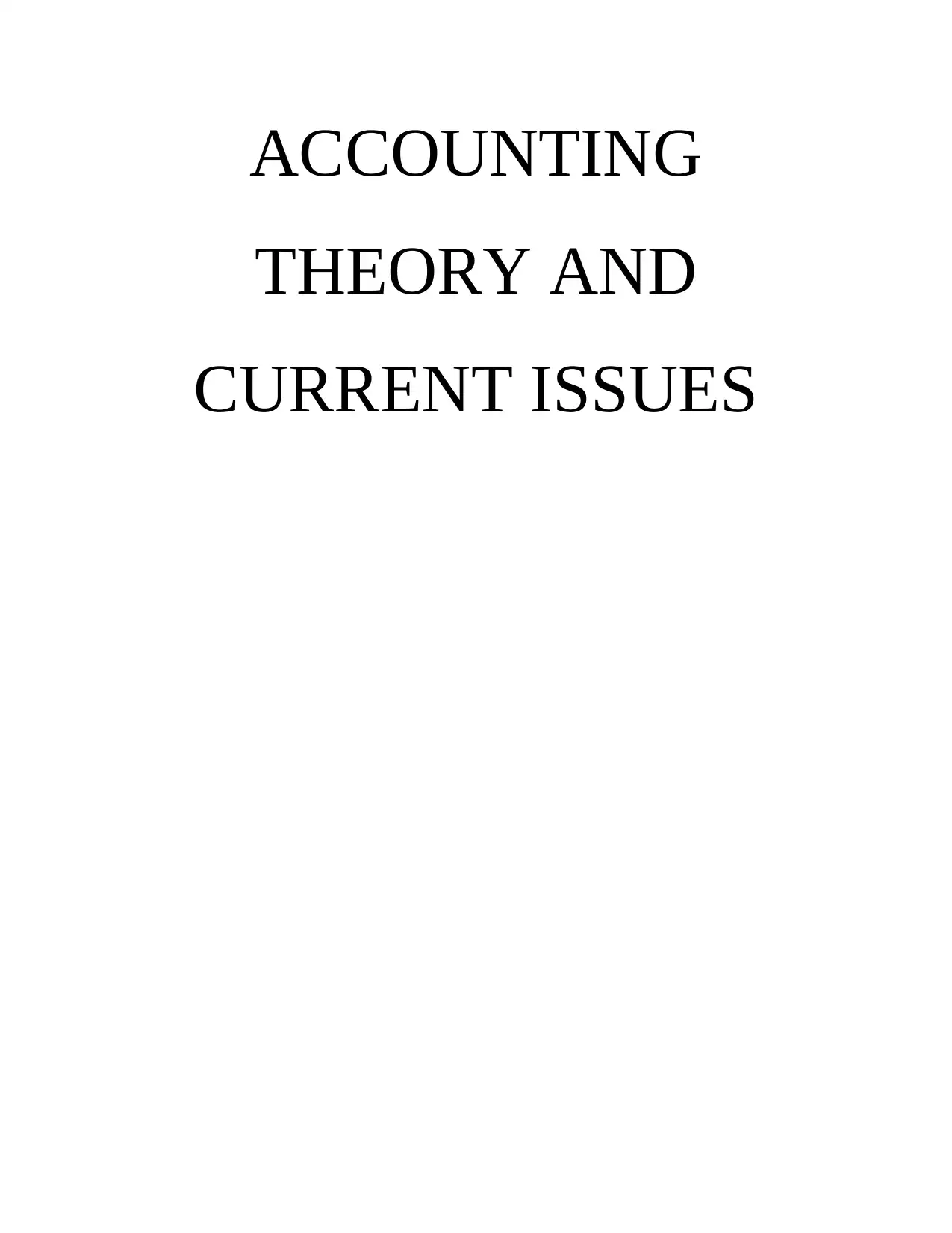
ACCOUNTING
THEORY AND
CURRENT ISSUES
THEORY AND
CURRENT ISSUES
Paraphrase This Document
Need a fresh take? Get an instant paraphrase of this document with our AI Paraphraser
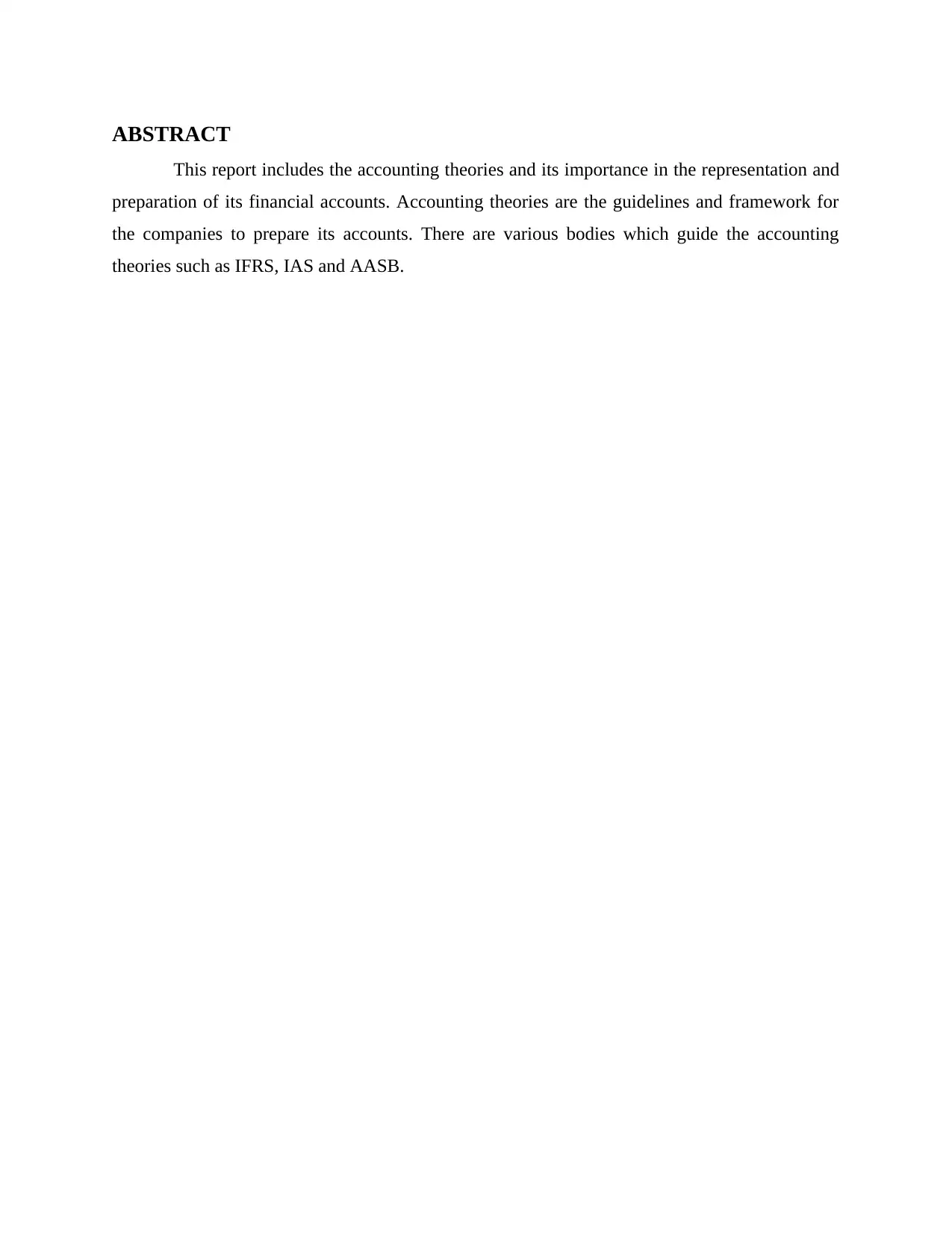
ABSTRACT
This report includes the accounting theories and its importance in the representation and
preparation of its financial accounts. Accounting theories are the guidelines and framework for
the companies to prepare its accounts. There are various bodies which guide the accounting
theories such as IFRS, IAS and AASB.
This report includes the accounting theories and its importance in the representation and
preparation of its financial accounts. Accounting theories are the guidelines and framework for
the companies to prepare its accounts. There are various bodies which guide the accounting
theories such as IFRS, IAS and AASB.
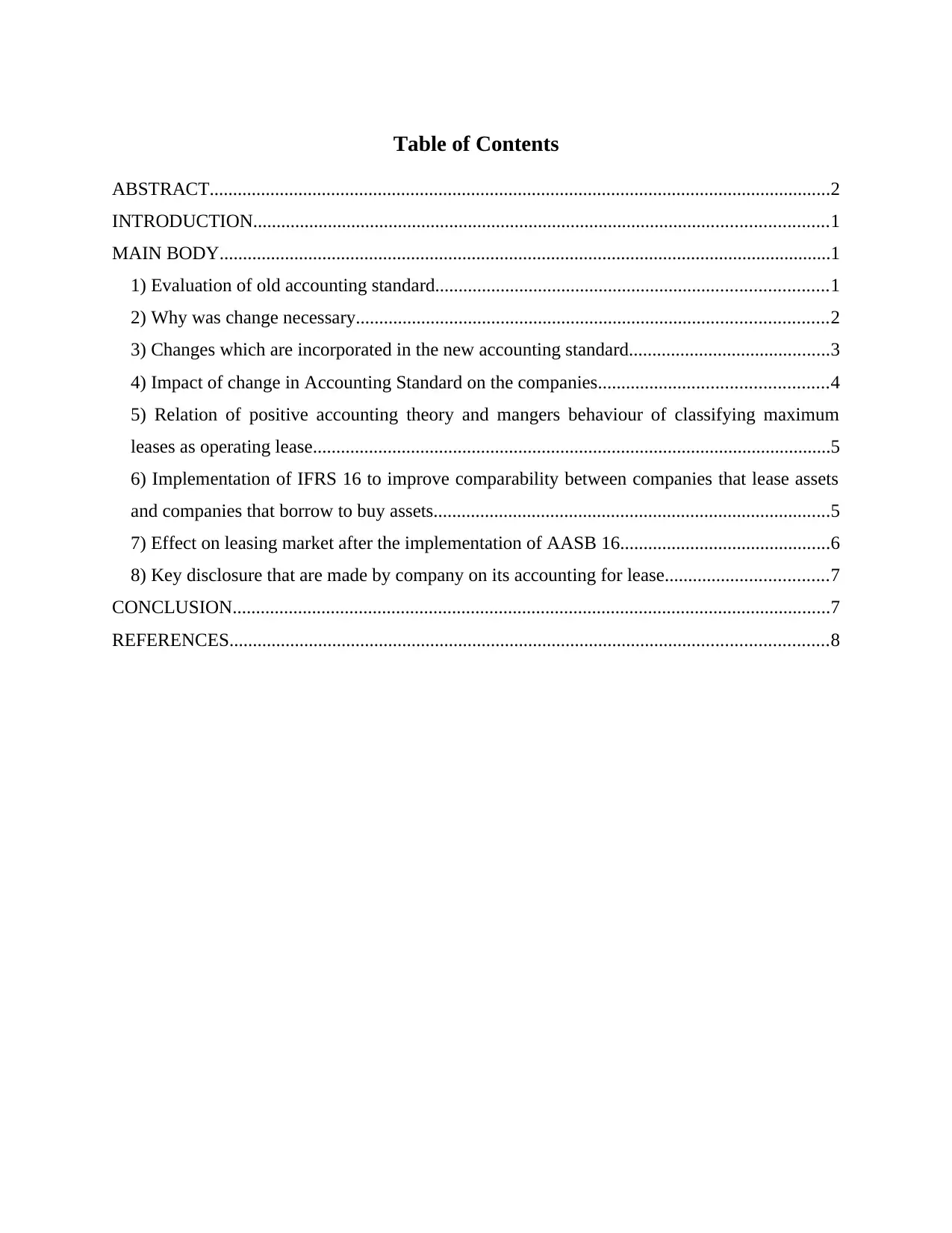
Table of Contents
ABSTRACT.....................................................................................................................................2
INTRODUCTION...........................................................................................................................1
MAIN BODY...................................................................................................................................1
1) Evaluation of old accounting standard....................................................................................1
2) Why was change necessary.....................................................................................................2
3) Changes which are incorporated in the new accounting standard...........................................3
4) Impact of change in Accounting Standard on the companies.................................................4
5) Relation of positive accounting theory and mangers behaviour of classifying maximum
leases as operating lease...............................................................................................................5
6) Implementation of IFRS 16 to improve comparability between companies that lease assets
and companies that borrow to buy assets.....................................................................................5
7) Effect on leasing market after the implementation of AASB 16.............................................6
8) Key disclosure that are made by company on its accounting for lease...................................7
CONCLUSION................................................................................................................................7
REFERENCES................................................................................................................................8
ABSTRACT.....................................................................................................................................2
INTRODUCTION...........................................................................................................................1
MAIN BODY...................................................................................................................................1
1) Evaluation of old accounting standard....................................................................................1
2) Why was change necessary.....................................................................................................2
3) Changes which are incorporated in the new accounting standard...........................................3
4) Impact of change in Accounting Standard on the companies.................................................4
5) Relation of positive accounting theory and mangers behaviour of classifying maximum
leases as operating lease...............................................................................................................5
6) Implementation of IFRS 16 to improve comparability between companies that lease assets
and companies that borrow to buy assets.....................................................................................5
7) Effect on leasing market after the implementation of AASB 16.............................................6
8) Key disclosure that are made by company on its accounting for lease...................................7
CONCLUSION................................................................................................................................7
REFERENCES................................................................................................................................8
⊘ This is a preview!⊘
Do you want full access?
Subscribe today to unlock all pages.

Trusted by 1+ million students worldwide
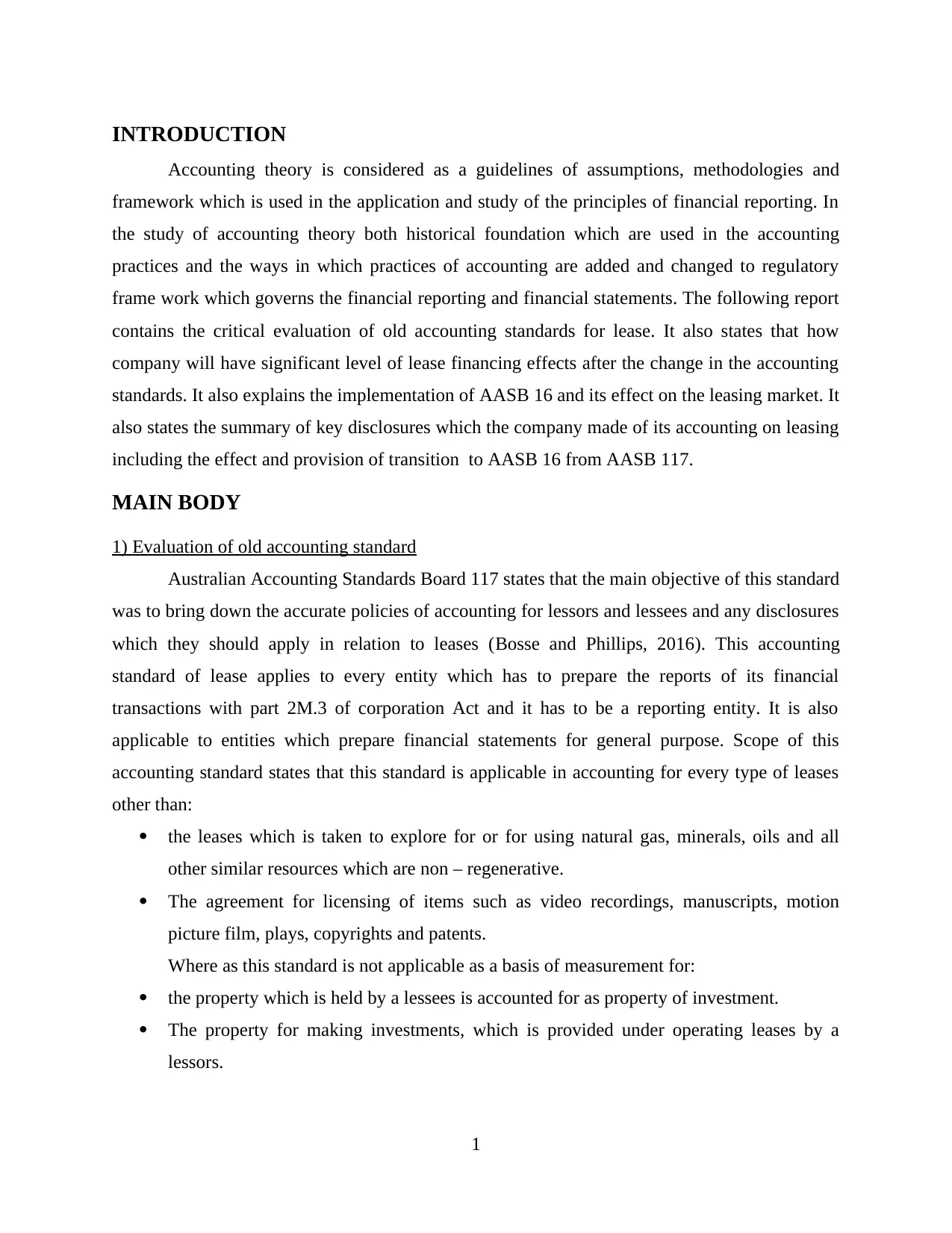
INTRODUCTION
Accounting theory is considered as a guidelines of assumptions, methodologies and
framework which is used in the application and study of the principles of financial reporting. In
the study of accounting theory both historical foundation which are used in the accounting
practices and the ways in which practices of accounting are added and changed to regulatory
frame work which governs the financial reporting and financial statements. The following report
contains the critical evaluation of old accounting standards for lease. It also states that how
company will have significant level of lease financing effects after the change in the accounting
standards. It also explains the implementation of AASB 16 and its effect on the leasing market. It
also states the summary of key disclosures which the company made of its accounting on leasing
including the effect and provision of transition to AASB 16 from AASB 117.
MAIN BODY
1) Evaluation of old accounting standard
Australian Accounting Standards Board 117 states that the main objective of this standard
was to bring down the accurate policies of accounting for lessors and lessees and any disclosures
which they should apply in relation to leases (Bosse and Phillips, 2016). This accounting
standard of lease applies to every entity which has to prepare the reports of its financial
transactions with part 2M.3 of corporation Act and it has to be a reporting entity. It is also
applicable to entities which prepare financial statements for general purpose. Scope of this
accounting standard states that this standard is applicable in accounting for every type of leases
other than:
the leases which is taken to explore for or for using natural gas, minerals, oils and all
other similar resources which are non – regenerative.
The agreement for licensing of items such as video recordings, manuscripts, motion
picture film, plays, copyrights and patents.
Where as this standard is not applicable as a basis of measurement for:
the property which is held by a lessees is accounted for as property of investment.
The property for making investments, which is provided under operating leases by a
lessors.
1
Accounting theory is considered as a guidelines of assumptions, methodologies and
framework which is used in the application and study of the principles of financial reporting. In
the study of accounting theory both historical foundation which are used in the accounting
practices and the ways in which practices of accounting are added and changed to regulatory
frame work which governs the financial reporting and financial statements. The following report
contains the critical evaluation of old accounting standards for lease. It also states that how
company will have significant level of lease financing effects after the change in the accounting
standards. It also explains the implementation of AASB 16 and its effect on the leasing market. It
also states the summary of key disclosures which the company made of its accounting on leasing
including the effect and provision of transition to AASB 16 from AASB 117.
MAIN BODY
1) Evaluation of old accounting standard
Australian Accounting Standards Board 117 states that the main objective of this standard
was to bring down the accurate policies of accounting for lessors and lessees and any disclosures
which they should apply in relation to leases (Bosse and Phillips, 2016). This accounting
standard of lease applies to every entity which has to prepare the reports of its financial
transactions with part 2M.3 of corporation Act and it has to be a reporting entity. It is also
applicable to entities which prepare financial statements for general purpose. Scope of this
accounting standard states that this standard is applicable in accounting for every type of leases
other than:
the leases which is taken to explore for or for using natural gas, minerals, oils and all
other similar resources which are non – regenerative.
The agreement for licensing of items such as video recordings, manuscripts, motion
picture film, plays, copyrights and patents.
Where as this standard is not applicable as a basis of measurement for:
the property which is held by a lessees is accounted for as property of investment.
The property for making investments, which is provided under operating leases by a
lessors.
1
Paraphrase This Document
Need a fresh take? Get an instant paraphrase of this document with our AI Paraphraser
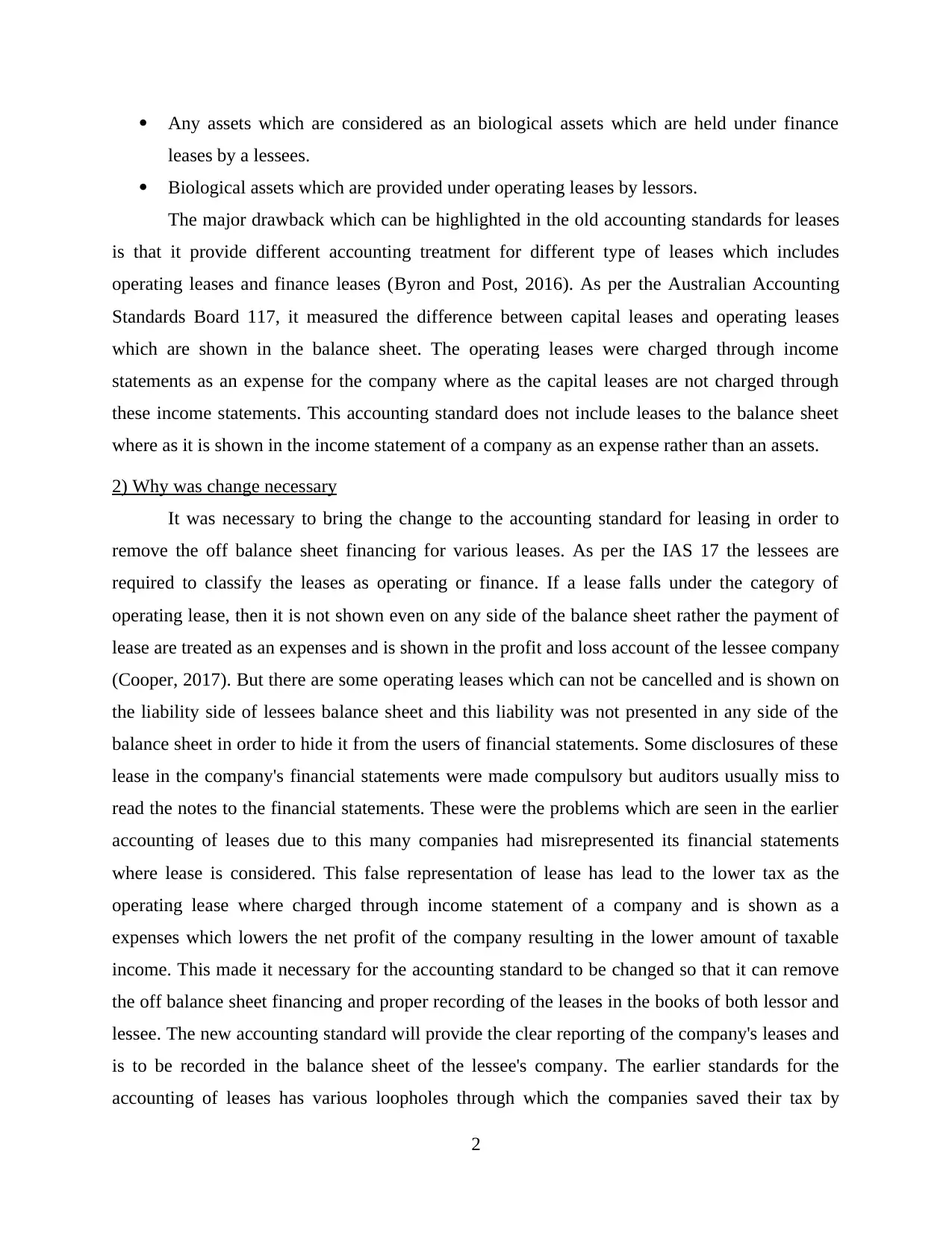
Any assets which are considered as an biological assets which are held under finance
leases by a lessees.
Biological assets which are provided under operating leases by lessors.
The major drawback which can be highlighted in the old accounting standards for leases
is that it provide different accounting treatment for different type of leases which includes
operating leases and finance leases (Byron and Post, 2016). As per the Australian Accounting
Standards Board 117, it measured the difference between capital leases and operating leases
which are shown in the balance sheet. The operating leases were charged through income
statements as an expense for the company where as the capital leases are not charged through
these income statements. This accounting standard does not include leases to the balance sheet
where as it is shown in the income statement of a company as an expense rather than an assets.
2) Why was change necessary
It was necessary to bring the change to the accounting standard for leasing in order to
remove the off balance sheet financing for various leases. As per the IAS 17 the lessees are
required to classify the leases as operating or finance. If a lease falls under the category of
operating lease, then it is not shown even on any side of the balance sheet rather the payment of
lease are treated as an expenses and is shown in the profit and loss account of the lessee company
(Cooper, 2017). But there are some operating leases which can not be cancelled and is shown on
the liability side of lessees balance sheet and this liability was not presented in any side of the
balance sheet in order to hide it from the users of financial statements. Some disclosures of these
lease in the company's financial statements were made compulsory but auditors usually miss to
read the notes to the financial statements. These were the problems which are seen in the earlier
accounting of leases due to this many companies had misrepresented its financial statements
where lease is considered. This false representation of lease has lead to the lower tax as the
operating lease where charged through income statement of a company and is shown as a
expenses which lowers the net profit of the company resulting in the lower amount of taxable
income. This made it necessary for the accounting standard to be changed so that it can remove
the off balance sheet financing and proper recording of the leases in the books of both lessor and
lessee. The new accounting standard will provide the clear reporting of the company's leases and
is to be recorded in the balance sheet of the lessee's company. The earlier standards for the
accounting of leases has various loopholes through which the companies saved their tax by
2
leases by a lessees.
Biological assets which are provided under operating leases by lessors.
The major drawback which can be highlighted in the old accounting standards for leases
is that it provide different accounting treatment for different type of leases which includes
operating leases and finance leases (Byron and Post, 2016). As per the Australian Accounting
Standards Board 117, it measured the difference between capital leases and operating leases
which are shown in the balance sheet. The operating leases were charged through income
statements as an expense for the company where as the capital leases are not charged through
these income statements. This accounting standard does not include leases to the balance sheet
where as it is shown in the income statement of a company as an expense rather than an assets.
2) Why was change necessary
It was necessary to bring the change to the accounting standard for leasing in order to
remove the off balance sheet financing for various leases. As per the IAS 17 the lessees are
required to classify the leases as operating or finance. If a lease falls under the category of
operating lease, then it is not shown even on any side of the balance sheet rather the payment of
lease are treated as an expenses and is shown in the profit and loss account of the lessee company
(Cooper, 2017). But there are some operating leases which can not be cancelled and is shown on
the liability side of lessees balance sheet and this liability was not presented in any side of the
balance sheet in order to hide it from the users of financial statements. Some disclosures of these
lease in the company's financial statements were made compulsory but auditors usually miss to
read the notes to the financial statements. These were the problems which are seen in the earlier
accounting of leases due to this many companies had misrepresented its financial statements
where lease is considered. This false representation of lease has lead to the lower tax as the
operating lease where charged through income statement of a company and is shown as a
expenses which lowers the net profit of the company resulting in the lower amount of taxable
income. This made it necessary for the accounting standard to be changed so that it can remove
the off balance sheet financing and proper recording of the leases in the books of both lessor and
lessee. The new accounting standard will provide the clear reporting of the company's leases and
is to be recorded in the balance sheet of the lessee's company. The earlier standards for the
accounting of leases has various loopholes through which the companies saved their tax by
2
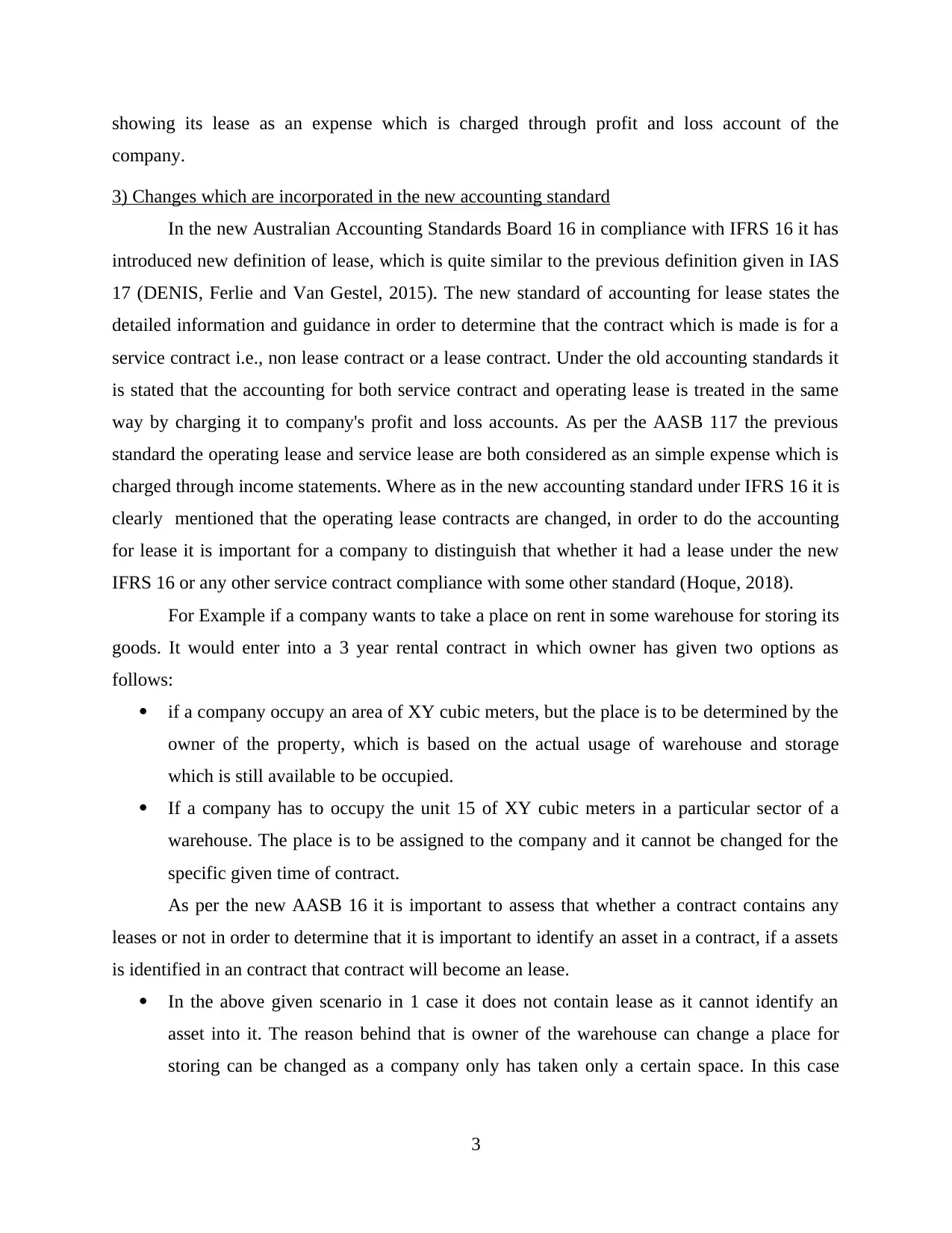
showing its lease as an expense which is charged through profit and loss account of the
company.
3) Changes which are incorporated in the new accounting standard
In the new Australian Accounting Standards Board 16 in compliance with IFRS 16 it has
introduced new definition of lease, which is quite similar to the previous definition given in IAS
17 (DENIS, Ferlie and Van Gestel, 2015). The new standard of accounting for lease states the
detailed information and guidance in order to determine that the contract which is made is for a
service contract i.e., non lease contract or a lease contract. Under the old accounting standards it
is stated that the accounting for both service contract and operating lease is treated in the same
way by charging it to company's profit and loss accounts. As per the AASB 117 the previous
standard the operating lease and service lease are both considered as an simple expense which is
charged through income statements. Where as in the new accounting standard under IFRS 16 it is
clearly mentioned that the operating lease contracts are changed, in order to do the accounting
for lease it is important for a company to distinguish that whether it had a lease under the new
IFRS 16 or any other service contract compliance with some other standard (Hoque, 2018).
For Example if a company wants to take a place on rent in some warehouse for storing its
goods. It would enter into a 3 year rental contract in which owner has given two options as
follows:
if a company occupy an area of XY cubic meters, but the place is to be determined by the
owner of the property, which is based on the actual usage of warehouse and storage
which is still available to be occupied.
If a company has to occupy the unit 15 of XY cubic meters in a particular sector of a
warehouse. The place is to be assigned to the company and it cannot be changed for the
specific given time of contract.
As per the new AASB 16 it is important to assess that whether a contract contains any
leases or not in order to determine that it is important to identify an asset in a contract, if a assets
is identified in an contract that contract will become an lease.
In the above given scenario in 1 case it does not contain lease as it cannot identify an
asset into it. The reason behind that is owner of the warehouse can change a place for
storing can be changed as a company only has taken only a certain space. In this case
3
company.
3) Changes which are incorporated in the new accounting standard
In the new Australian Accounting Standards Board 16 in compliance with IFRS 16 it has
introduced new definition of lease, which is quite similar to the previous definition given in IAS
17 (DENIS, Ferlie and Van Gestel, 2015). The new standard of accounting for lease states the
detailed information and guidance in order to determine that the contract which is made is for a
service contract i.e., non lease contract or a lease contract. Under the old accounting standards it
is stated that the accounting for both service contract and operating lease is treated in the same
way by charging it to company's profit and loss accounts. As per the AASB 117 the previous
standard the operating lease and service lease are both considered as an simple expense which is
charged through income statements. Where as in the new accounting standard under IFRS 16 it is
clearly mentioned that the operating lease contracts are changed, in order to do the accounting
for lease it is important for a company to distinguish that whether it had a lease under the new
IFRS 16 or any other service contract compliance with some other standard (Hoque, 2018).
For Example if a company wants to take a place on rent in some warehouse for storing its
goods. It would enter into a 3 year rental contract in which owner has given two options as
follows:
if a company occupy an area of XY cubic meters, but the place is to be determined by the
owner of the property, which is based on the actual usage of warehouse and storage
which is still available to be occupied.
If a company has to occupy the unit 15 of XY cubic meters in a particular sector of a
warehouse. The place is to be assigned to the company and it cannot be changed for the
specific given time of contract.
As per the new AASB 16 it is important to assess that whether a contract contains any
leases or not in order to determine that it is important to identify an asset in a contract, if a assets
is identified in an contract that contract will become an lease.
In the above given scenario in 1 case it does not contain lease as it cannot identify an
asset into it. The reason behind that is owner of the warehouse can change a place for
storing can be changed as a company only has taken only a certain space. In this case
3
⊘ This is a preview!⊘
Do you want full access?
Subscribe today to unlock all pages.

Trusted by 1+ million students worldwide
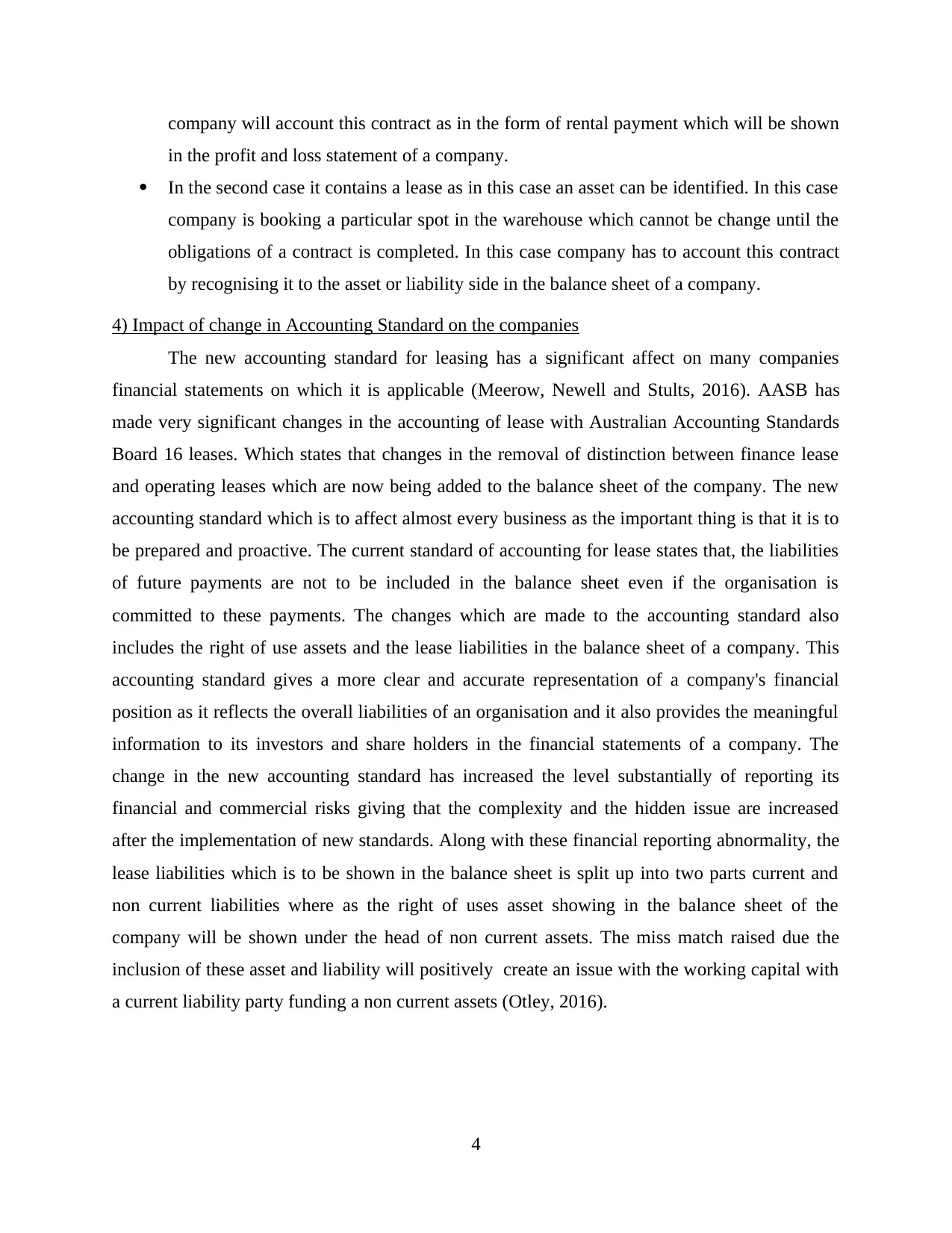
company will account this contract as in the form of rental payment which will be shown
in the profit and loss statement of a company.
In the second case it contains a lease as in this case an asset can be identified. In this case
company is booking a particular spot in the warehouse which cannot be change until the
obligations of a contract is completed. In this case company has to account this contract
by recognising it to the asset or liability side in the balance sheet of a company.
4) Impact of change in Accounting Standard on the companies
The new accounting standard for leasing has a significant affect on many companies
financial statements on which it is applicable (Meerow, Newell and Stults, 2016). AASB has
made very significant changes in the accounting of lease with Australian Accounting Standards
Board 16 leases. Which states that changes in the removal of distinction between finance lease
and operating leases which are now being added to the balance sheet of the company. The new
accounting standard which is to affect almost every business as the important thing is that it is to
be prepared and proactive. The current standard of accounting for lease states that, the liabilities
of future payments are not to be included in the balance sheet even if the organisation is
committed to these payments. The changes which are made to the accounting standard also
includes the right of use assets and the lease liabilities in the balance sheet of a company. This
accounting standard gives a more clear and accurate representation of a company's financial
position as it reflects the overall liabilities of an organisation and it also provides the meaningful
information to its investors and share holders in the financial statements of a company. The
change in the new accounting standard has increased the level substantially of reporting its
financial and commercial risks giving that the complexity and the hidden issue are increased
after the implementation of new standards. Along with these financial reporting abnormality, the
lease liabilities which is to be shown in the balance sheet is split up into two parts current and
non current liabilities where as the right of uses asset showing in the balance sheet of the
company will be shown under the head of non current assets. The miss match raised due the
inclusion of these asset and liability will positively create an issue with the working capital with
a current liability party funding a non current assets (Otley, 2016).
4
in the profit and loss statement of a company.
In the second case it contains a lease as in this case an asset can be identified. In this case
company is booking a particular spot in the warehouse which cannot be change until the
obligations of a contract is completed. In this case company has to account this contract
by recognising it to the asset or liability side in the balance sheet of a company.
4) Impact of change in Accounting Standard on the companies
The new accounting standard for leasing has a significant affect on many companies
financial statements on which it is applicable (Meerow, Newell and Stults, 2016). AASB has
made very significant changes in the accounting of lease with Australian Accounting Standards
Board 16 leases. Which states that changes in the removal of distinction between finance lease
and operating leases which are now being added to the balance sheet of the company. The new
accounting standard which is to affect almost every business as the important thing is that it is to
be prepared and proactive. The current standard of accounting for lease states that, the liabilities
of future payments are not to be included in the balance sheet even if the organisation is
committed to these payments. The changes which are made to the accounting standard also
includes the right of use assets and the lease liabilities in the balance sheet of a company. This
accounting standard gives a more clear and accurate representation of a company's financial
position as it reflects the overall liabilities of an organisation and it also provides the meaningful
information to its investors and share holders in the financial statements of a company. The
change in the new accounting standard has increased the level substantially of reporting its
financial and commercial risks giving that the complexity and the hidden issue are increased
after the implementation of new standards. Along with these financial reporting abnormality, the
lease liabilities which is to be shown in the balance sheet is split up into two parts current and
non current liabilities where as the right of uses asset showing in the balance sheet of the
company will be shown under the head of non current assets. The miss match raised due the
inclusion of these asset and liability will positively create an issue with the working capital with
a current liability party funding a non current assets (Otley, 2016).
4
Paraphrase This Document
Need a fresh take? Get an instant paraphrase of this document with our AI Paraphraser
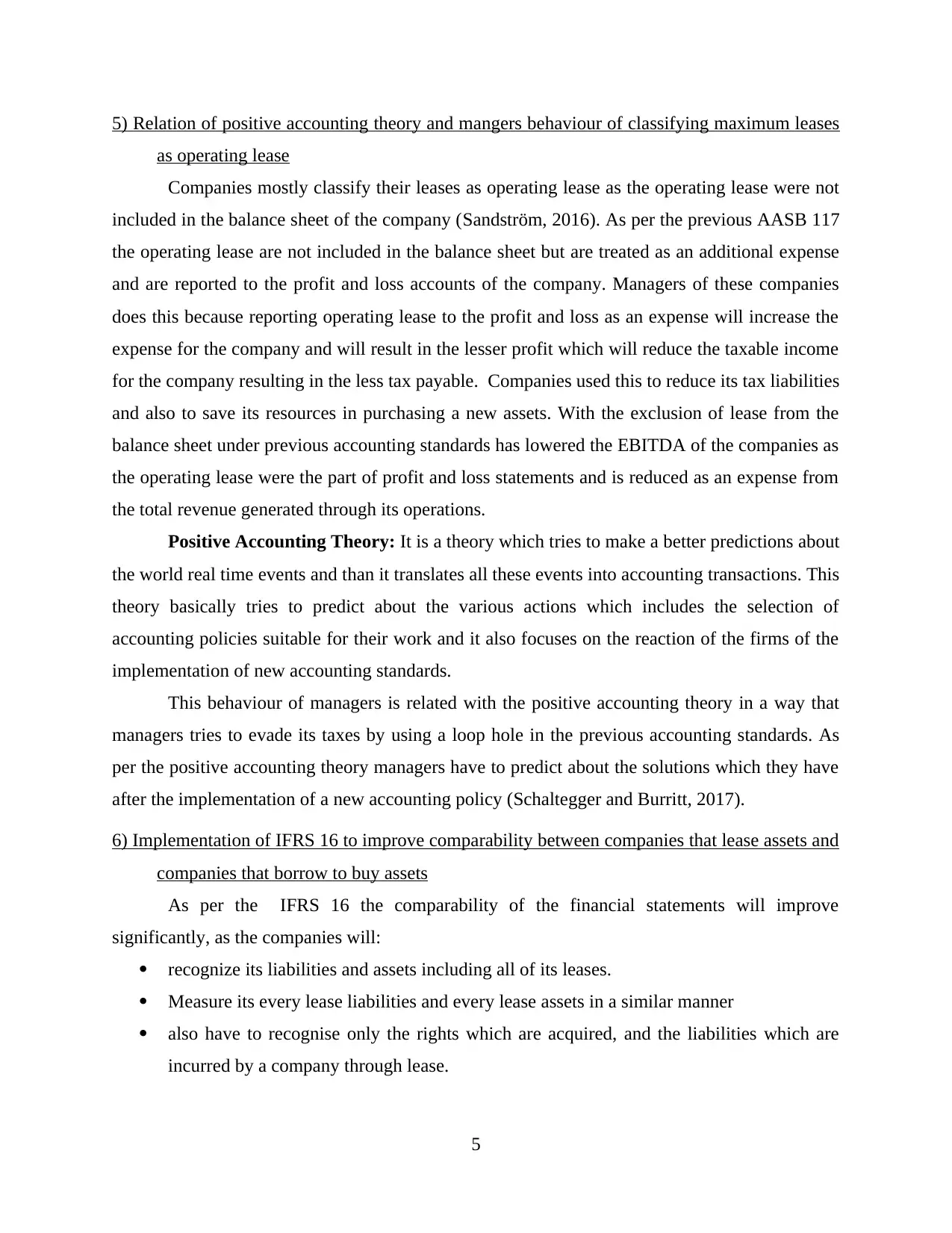
5) Relation of positive accounting theory and mangers behaviour of classifying maximum leases
as operating lease
Companies mostly classify their leases as operating lease as the operating lease were not
included in the balance sheet of the company (Sandström, 2016). As per the previous AASB 117
the operating lease are not included in the balance sheet but are treated as an additional expense
and are reported to the profit and loss accounts of the company. Managers of these companies
does this because reporting operating lease to the profit and loss as an expense will increase the
expense for the company and will result in the lesser profit which will reduce the taxable income
for the company resulting in the less tax payable. Companies used this to reduce its tax liabilities
and also to save its resources in purchasing a new assets. With the exclusion of lease from the
balance sheet under previous accounting standards has lowered the EBITDA of the companies as
the operating lease were the part of profit and loss statements and is reduced as an expense from
the total revenue generated through its operations.
Positive Accounting Theory: It is a theory which tries to make a better predictions about
the world real time events and than it translates all these events into accounting transactions. This
theory basically tries to predict about the various actions which includes the selection of
accounting policies suitable for their work and it also focuses on the reaction of the firms of the
implementation of new accounting standards.
This behaviour of managers is related with the positive accounting theory in a way that
managers tries to evade its taxes by using a loop hole in the previous accounting standards. As
per the positive accounting theory managers have to predict about the solutions which they have
after the implementation of a new accounting policy (Schaltegger and Burritt, 2017).
6) Implementation of IFRS 16 to improve comparability between companies that lease assets and
companies that borrow to buy assets
As per the IFRS 16 the comparability of the financial statements will improve
significantly, as the companies will:
recognize its liabilities and assets including all of its leases.
Measure its every lease liabilities and every lease assets in a similar manner
also have to recognise only the rights which are acquired, and the liabilities which are
incurred by a company through lease.
5
as operating lease
Companies mostly classify their leases as operating lease as the operating lease were not
included in the balance sheet of the company (Sandström, 2016). As per the previous AASB 117
the operating lease are not included in the balance sheet but are treated as an additional expense
and are reported to the profit and loss accounts of the company. Managers of these companies
does this because reporting operating lease to the profit and loss as an expense will increase the
expense for the company and will result in the lesser profit which will reduce the taxable income
for the company resulting in the less tax payable. Companies used this to reduce its tax liabilities
and also to save its resources in purchasing a new assets. With the exclusion of lease from the
balance sheet under previous accounting standards has lowered the EBITDA of the companies as
the operating lease were the part of profit and loss statements and is reduced as an expense from
the total revenue generated through its operations.
Positive Accounting Theory: It is a theory which tries to make a better predictions about
the world real time events and than it translates all these events into accounting transactions. This
theory basically tries to predict about the various actions which includes the selection of
accounting policies suitable for their work and it also focuses on the reaction of the firms of the
implementation of new accounting standards.
This behaviour of managers is related with the positive accounting theory in a way that
managers tries to evade its taxes by using a loop hole in the previous accounting standards. As
per the positive accounting theory managers have to predict about the solutions which they have
after the implementation of a new accounting policy (Schaltegger and Burritt, 2017).
6) Implementation of IFRS 16 to improve comparability between companies that lease assets and
companies that borrow to buy assets
As per the IFRS 16 the comparability of the financial statements will improve
significantly, as the companies will:
recognize its liabilities and assets including all of its leases.
Measure its every lease liabilities and every lease assets in a similar manner
also have to recognise only the rights which are acquired, and the liabilities which are
incurred by a company through lease.
5
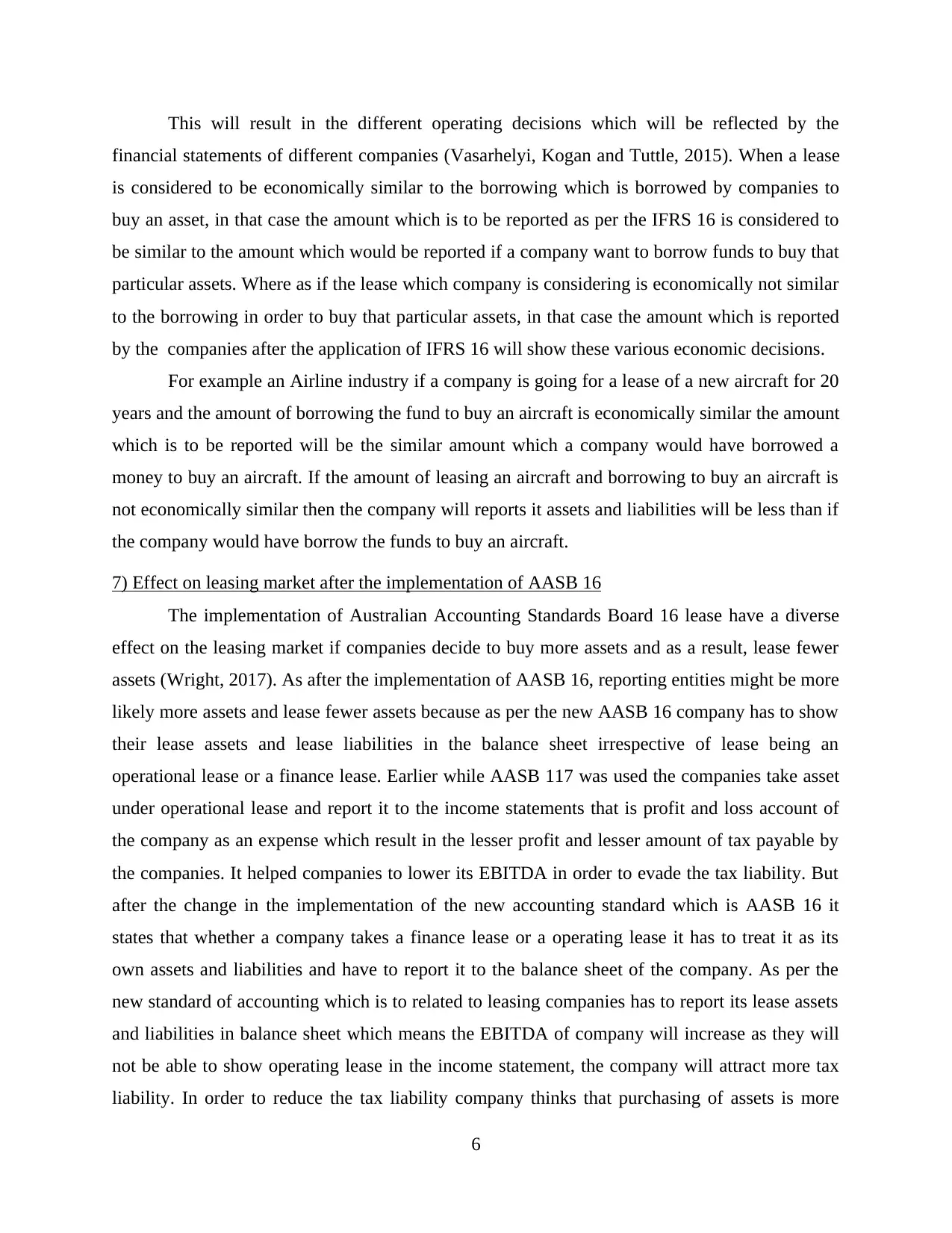
This will result in the different operating decisions which will be reflected by the
financial statements of different companies (Vasarhelyi, Kogan and Tuttle, 2015). When a lease
is considered to be economically similar to the borrowing which is borrowed by companies to
buy an asset, in that case the amount which is to be reported as per the IFRS 16 is considered to
be similar to the amount which would be reported if a company want to borrow funds to buy that
particular assets. Where as if the lease which company is considering is economically not similar
to the borrowing in order to buy that particular assets, in that case the amount which is reported
by the companies after the application of IFRS 16 will show these various economic decisions.
For example an Airline industry if a company is going for a lease of a new aircraft for 20
years and the amount of borrowing the fund to buy an aircraft is economically similar the amount
which is to be reported will be the similar amount which a company would have borrowed a
money to buy an aircraft. If the amount of leasing an aircraft and borrowing to buy an aircraft is
not economically similar then the company will reports it assets and liabilities will be less than if
the company would have borrow the funds to buy an aircraft.
7) Effect on leasing market after the implementation of AASB 16
The implementation of Australian Accounting Standards Board 16 lease have a diverse
effect on the leasing market if companies decide to buy more assets and as a result, lease fewer
assets (Wright, 2017). As after the implementation of AASB 16, reporting entities might be more
likely more assets and lease fewer assets because as per the new AASB 16 company has to show
their lease assets and lease liabilities in the balance sheet irrespective of lease being an
operational lease or a finance lease. Earlier while AASB 117 was used the companies take asset
under operational lease and report it to the income statements that is profit and loss account of
the company as an expense which result in the lesser profit and lesser amount of tax payable by
the companies. It helped companies to lower its EBITDA in order to evade the tax liability. But
after the change in the implementation of the new accounting standard which is AASB 16 it
states that whether a company takes a finance lease or a operating lease it has to treat it as its
own assets and liabilities and have to report it to the balance sheet of the company. As per the
new standard of accounting which is to related to leasing companies has to report its lease assets
and liabilities in balance sheet which means the EBITDA of company will increase as they will
not be able to show operating lease in the income statement, the company will attract more tax
liability. In order to reduce the tax liability company thinks that purchasing of assets is more
6
financial statements of different companies (Vasarhelyi, Kogan and Tuttle, 2015). When a lease
is considered to be economically similar to the borrowing which is borrowed by companies to
buy an asset, in that case the amount which is to be reported as per the IFRS 16 is considered to
be similar to the amount which would be reported if a company want to borrow funds to buy that
particular assets. Where as if the lease which company is considering is economically not similar
to the borrowing in order to buy that particular assets, in that case the amount which is reported
by the companies after the application of IFRS 16 will show these various economic decisions.
For example an Airline industry if a company is going for a lease of a new aircraft for 20
years and the amount of borrowing the fund to buy an aircraft is economically similar the amount
which is to be reported will be the similar amount which a company would have borrowed a
money to buy an aircraft. If the amount of leasing an aircraft and borrowing to buy an aircraft is
not economically similar then the company will reports it assets and liabilities will be less than if
the company would have borrow the funds to buy an aircraft.
7) Effect on leasing market after the implementation of AASB 16
The implementation of Australian Accounting Standards Board 16 lease have a diverse
effect on the leasing market if companies decide to buy more assets and as a result, lease fewer
assets (Wright, 2017). As after the implementation of AASB 16, reporting entities might be more
likely more assets and lease fewer assets because as per the new AASB 16 company has to show
their lease assets and lease liabilities in the balance sheet irrespective of lease being an
operational lease or a finance lease. Earlier while AASB 117 was used the companies take asset
under operational lease and report it to the income statements that is profit and loss account of
the company as an expense which result in the lesser profit and lesser amount of tax payable by
the companies. It helped companies to lower its EBITDA in order to evade the tax liability. But
after the change in the implementation of the new accounting standard which is AASB 16 it
states that whether a company takes a finance lease or a operating lease it has to treat it as its
own assets and liabilities and have to report it to the balance sheet of the company. As per the
new standard of accounting which is to related to leasing companies has to report its lease assets
and liabilities in balance sheet which means the EBITDA of company will increase as they will
not be able to show operating lease in the income statement, the company will attract more tax
liability. In order to reduce the tax liability company thinks that purchasing of assets is more
6
⊘ This is a preview!⊘
Do you want full access?
Subscribe today to unlock all pages.

Trusted by 1+ million students worldwide
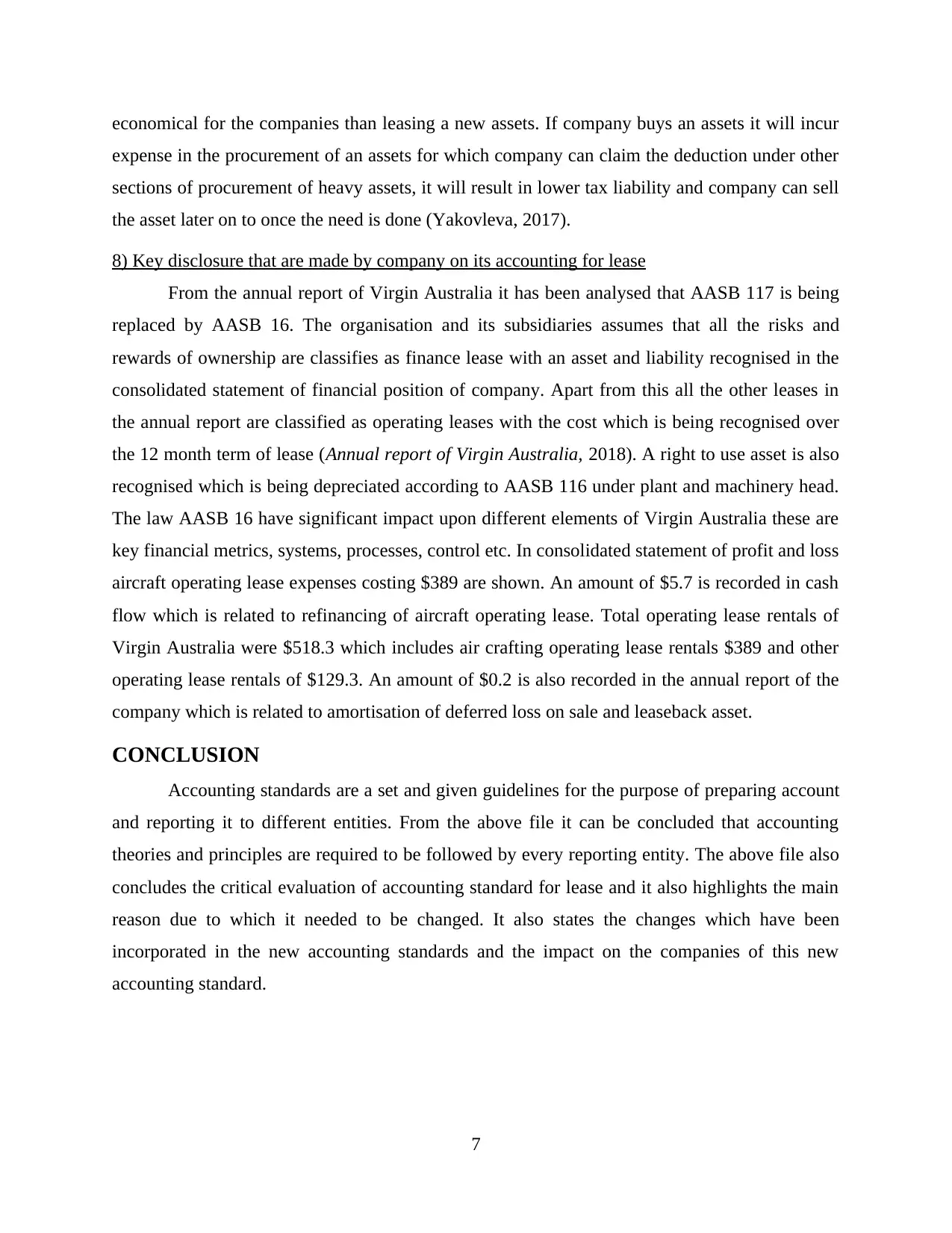
economical for the companies than leasing a new assets. If company buys an assets it will incur
expense in the procurement of an assets for which company can claim the deduction under other
sections of procurement of heavy assets, it will result in lower tax liability and company can sell
the asset later on to once the need is done (Yakovleva, 2017).
8) Key disclosure that are made by company on its accounting for lease
From the annual report of Virgin Australia it has been analysed that AASB 117 is being
replaced by AASB 16. The organisation and its subsidiaries assumes that all the risks and
rewards of ownership are classifies as finance lease with an asset and liability recognised in the
consolidated statement of financial position of company. Apart from this all the other leases in
the annual report are classified as operating leases with the cost which is being recognised over
the 12 month term of lease (Annual report of Virgin Australia, 2018). A right to use asset is also
recognised which is being depreciated according to AASB 116 under plant and machinery head.
The law AASB 16 have significant impact upon different elements of Virgin Australia these are
key financial metrics, systems, processes, control etc. In consolidated statement of profit and loss
aircraft operating lease expenses costing $389 are shown. An amount of $5.7 is recorded in cash
flow which is related to refinancing of aircraft operating lease. Total operating lease rentals of
Virgin Australia were $518.3 which includes air crafting operating lease rentals $389 and other
operating lease rentals of $129.3. An amount of $0.2 is also recorded in the annual report of the
company which is related to amortisation of deferred loss on sale and leaseback asset.
CONCLUSION
Accounting standards are a set and given guidelines for the purpose of preparing account
and reporting it to different entities. From the above file it can be concluded that accounting
theories and principles are required to be followed by every reporting entity. The above file also
concludes the critical evaluation of accounting standard for lease and it also highlights the main
reason due to which it needed to be changed. It also states the changes which have been
incorporated in the new accounting standards and the impact on the companies of this new
accounting standard.
7
expense in the procurement of an assets for which company can claim the deduction under other
sections of procurement of heavy assets, it will result in lower tax liability and company can sell
the asset later on to once the need is done (Yakovleva, 2017).
8) Key disclosure that are made by company on its accounting for lease
From the annual report of Virgin Australia it has been analysed that AASB 117 is being
replaced by AASB 16. The organisation and its subsidiaries assumes that all the risks and
rewards of ownership are classifies as finance lease with an asset and liability recognised in the
consolidated statement of financial position of company. Apart from this all the other leases in
the annual report are classified as operating leases with the cost which is being recognised over
the 12 month term of lease (Annual report of Virgin Australia, 2018). A right to use asset is also
recognised which is being depreciated according to AASB 116 under plant and machinery head.
The law AASB 16 have significant impact upon different elements of Virgin Australia these are
key financial metrics, systems, processes, control etc. In consolidated statement of profit and loss
aircraft operating lease expenses costing $389 are shown. An amount of $5.7 is recorded in cash
flow which is related to refinancing of aircraft operating lease. Total operating lease rentals of
Virgin Australia were $518.3 which includes air crafting operating lease rentals $389 and other
operating lease rentals of $129.3. An amount of $0.2 is also recorded in the annual report of the
company which is related to amortisation of deferred loss on sale and leaseback asset.
CONCLUSION
Accounting standards are a set and given guidelines for the purpose of preparing account
and reporting it to different entities. From the above file it can be concluded that accounting
theories and principles are required to be followed by every reporting entity. The above file also
concludes the critical evaluation of accounting standard for lease and it also highlights the main
reason due to which it needed to be changed. It also states the changes which have been
incorporated in the new accounting standards and the impact on the companies of this new
accounting standard.
7
Paraphrase This Document
Need a fresh take? Get an instant paraphrase of this document with our AI Paraphraser
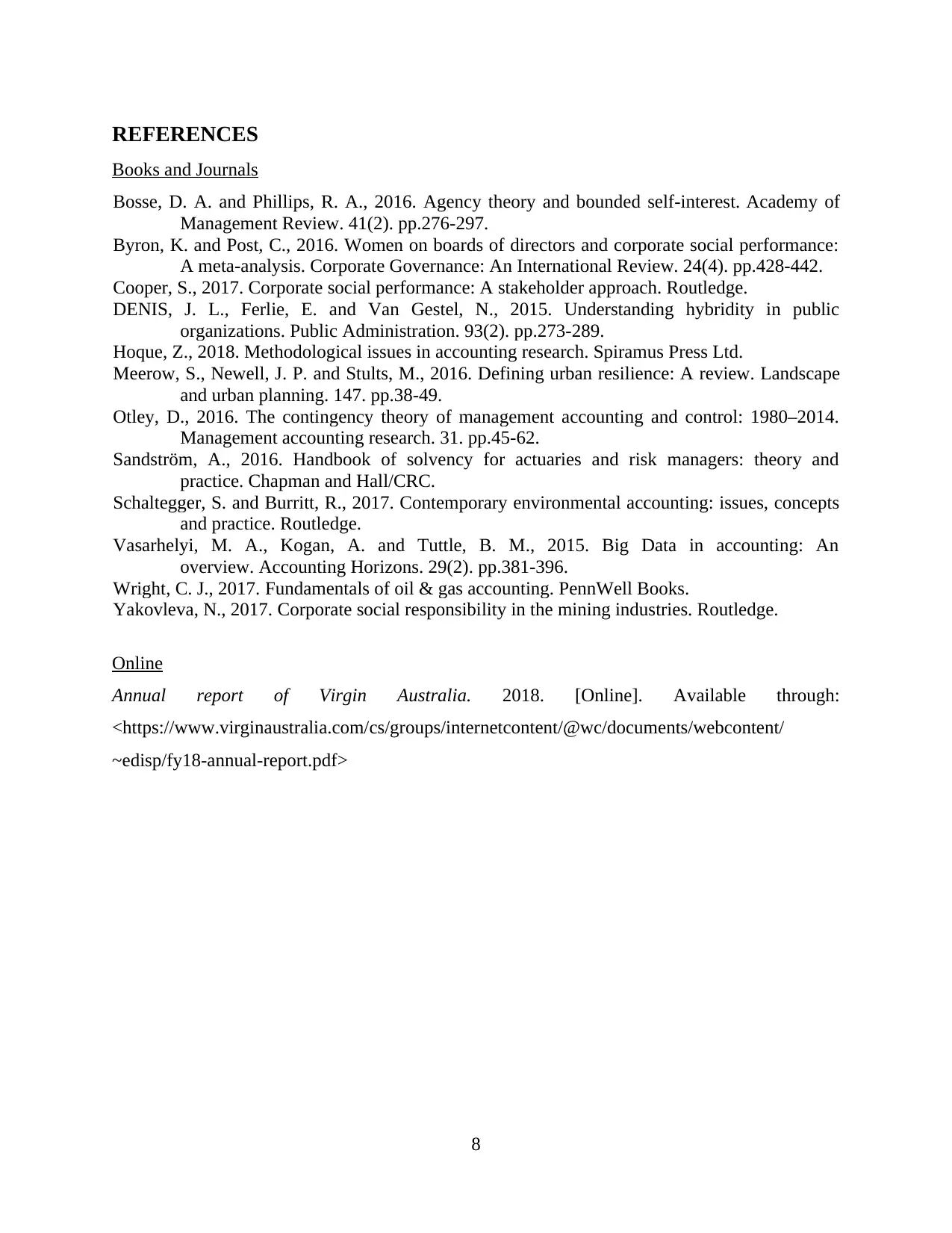
REFERENCES
Books and Journals
Bosse, D. A. and Phillips, R. A., 2016. Agency theory and bounded self-interest. Academy of
Management Review. 41(2). pp.276-297.
Byron, K. and Post, C., 2016. Women on boards of directors and corporate social performance:
A meta‐analysis. Corporate Governance: An International Review. 24(4). pp.428-442.
Cooper, S., 2017. Corporate social performance: A stakeholder approach. Routledge.
DENIS, J. L., Ferlie, E. and Van Gestel, N., 2015. Understanding hybridity in public
organizations. Public Administration. 93(2). pp.273-289.
Hoque, Z., 2018. Methodological issues in accounting research. Spiramus Press Ltd.
Meerow, S., Newell, J. P. and Stults, M., 2016. Defining urban resilience: A review. Landscape
and urban planning. 147. pp.38-49.
Otley, D., 2016. The contingency theory of management accounting and control: 1980–2014.
Management accounting research. 31. pp.45-62.
Sandström, A., 2016. Handbook of solvency for actuaries and risk managers: theory and
practice. Chapman and Hall/CRC.
Schaltegger, S. and Burritt, R., 2017. Contemporary environmental accounting: issues, concepts
and practice. Routledge.
Vasarhelyi, M. A., Kogan, A. and Tuttle, B. M., 2015. Big Data in accounting: An
overview. Accounting Horizons. 29(2). pp.381-396.
Wright, C. J., 2017. Fundamentals of oil & gas accounting. PennWell Books.
Yakovleva, N., 2017. Corporate social responsibility in the mining industries. Routledge.
Online
Annual report of Virgin Australia. 2018. [Online]. Available through:
<https://www.virginaustralia.com/cs/groups/internetcontent/@wc/documents/webcontent/
~edisp/fy18-annual-report.pdf>
8
Books and Journals
Bosse, D. A. and Phillips, R. A., 2016. Agency theory and bounded self-interest. Academy of
Management Review. 41(2). pp.276-297.
Byron, K. and Post, C., 2016. Women on boards of directors and corporate social performance:
A meta‐analysis. Corporate Governance: An International Review. 24(4). pp.428-442.
Cooper, S., 2017. Corporate social performance: A stakeholder approach. Routledge.
DENIS, J. L., Ferlie, E. and Van Gestel, N., 2015. Understanding hybridity in public
organizations. Public Administration. 93(2). pp.273-289.
Hoque, Z., 2018. Methodological issues in accounting research. Spiramus Press Ltd.
Meerow, S., Newell, J. P. and Stults, M., 2016. Defining urban resilience: A review. Landscape
and urban planning. 147. pp.38-49.
Otley, D., 2016. The contingency theory of management accounting and control: 1980–2014.
Management accounting research. 31. pp.45-62.
Sandström, A., 2016. Handbook of solvency for actuaries and risk managers: theory and
practice. Chapman and Hall/CRC.
Schaltegger, S. and Burritt, R., 2017. Contemporary environmental accounting: issues, concepts
and practice. Routledge.
Vasarhelyi, M. A., Kogan, A. and Tuttle, B. M., 2015. Big Data in accounting: An
overview. Accounting Horizons. 29(2). pp.381-396.
Wright, C. J., 2017. Fundamentals of oil & gas accounting. PennWell Books.
Yakovleva, N., 2017. Corporate social responsibility in the mining industries. Routledge.
Online
Annual report of Virgin Australia. 2018. [Online]. Available through:
<https://www.virginaustralia.com/cs/groups/internetcontent/@wc/documents/webcontent/
~edisp/fy18-annual-report.pdf>
8
1 out of 11
Related Documents
Your All-in-One AI-Powered Toolkit for Academic Success.
+13062052269
info@desklib.com
Available 24*7 on WhatsApp / Email
![[object Object]](/_next/static/media/star-bottom.7253800d.svg)
Unlock your academic potential
Copyright © 2020–2025 A2Z Services. All Rights Reserved. Developed and managed by ZUCOL.




